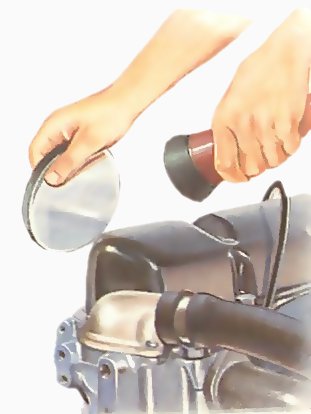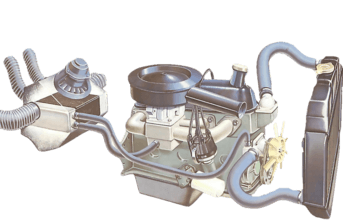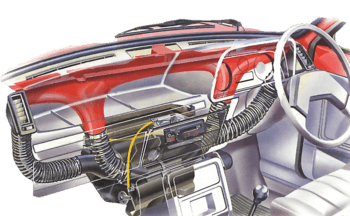A leak in the water-cooling system can be hard to trace - especially if it is internal, say in the cylinder-head gasket between cylinders.
Areas of the cooling system to check for leaks
Check the core plugs in the side of the cylinder block. Check all hose connections for tightness, but ensure that the clips are not cutting into the
rubber. Look along the hose for cracks, especially at points where the hose is flexed by engine movement.
Inspect the radiator seams for splits, also the catch tank and its pipe. Watch for leaks at the water-pump bearings and from the pump gasket.
Check the thermostat housing for cracks, and the housing gasket for leaks.
A rising temperature gauge, a pool of coolant beneath the car and a drop in the radiator level are signs of a leak. So are rust-coloured stains in the engine bay.
But if you cannot actually see the leak, a systematic check is called for.
This video course is the best way to learn everything about cars.
Three hours of instruction available right now, and many more hours in production.
- 4K HD with full subtitles
- Complete disassembly of a sports car
Always work when the engine is hot, and pressure in the cooling system has built up - forcing out coolant at any weak spot.
The likely sources of leaks are where a hose is flexed by engine movement over the end of the stub to which it is fitted, or where an overtightened clip has bitten into the rubber.
Seams at the top and bottom of the radiator are also danger spots.
Small leaks can sometimes be cured by sealing preparations available from shops and garages. But leakage from a radiator seam is best left to a garage.
Some cars have plastic coolant tanks, and leaks in them are also beyond do-it-yourself repair.
Always treat them gently - using a screwdriver to lever off an old hose can easily break off the stub.
Inspect hoses carefully at bends and joints, as well as where they clip on to stubs (See Checking hoses and the radiator cap).
Core plugs, which fill holes left in the cylinder block when it is being cast, are other likely sources of leaks. They may be blown loose by pressure from the system, corroded, or even loosened by vibration.
Hidden core plugs
Use a mirror to locate hidden plugs.
Use a mirror and torch to find if there is one hidden behind the engine, made inaccessible by the bulkhead.
If a thorough search fails to locate the leak, suspect a damaged gasket between the cylinder head and the cylinder block, or a cracked head or block.
If the cooling system springs a small leak when you are on the road, you may be able to drive home slowly by releasing the radiator cap to its first catch, or by putting a match under the vacuum valve of the cap to relieve the pressure. Watch the temperature gauge; if it goes into the danger area, stop and allow the engine to cool.
If you suspect an internal coolant leak, allow the radiator to cool, take off the cap, and look for signs of oil or frothy bubbles in the radiator or header tank.
With the engine running, smell the coolant itself - if there is a whiff of exhaust gas, the cylinder-head gasket may be leaking. To make certain this is the cause, before removing the cylinder head (See How to remove a cylinder head) to investigate, have a garage test the cooling system pressure.
Inspecting the water pump
If the fan is on the water pump, loosen the fan belt and rock the fan blades - any movement means worn bearings.
To check the water-pump bearings, loosen the drive belt (See Testing an alternator and checking output) then try to rock the fan blades backwards and forwards.
Any movement means that there is wear in the bearings. This will lead eventually to rupture of the water seal on the pump shaft, and a leak will occur. Look also for leaks around the pump flange, tightening the flange bolts or replacing the gasket may stop the leak. If the fan is not mounted on the water-pump pulley, rock the pulley instead.
If the fan is not on the water pump, rock the pulley instead.
A worn or leaking water pump must be replaced - it is false economy to have it repaired.
Another sign of wear is noise, but a screech when starting from cold or accelerating quickly may also be caused by the belt, generator bearings or a power-steering pump.
The most frequent cause of water pump failure is a loose, slipping, worn or damaged drive belt. This usually leads to overheating, a reduced charging rate - and eventually a broken belt.
The belt usually drives the generator, as well as the pump, and the tension on it is critical: too slack and it cannot turn the generator and water pump; too tight and it may damage the bearings of both.
To check and adjust the drive belt, see Checking, adjusting and refitting drive belts.









